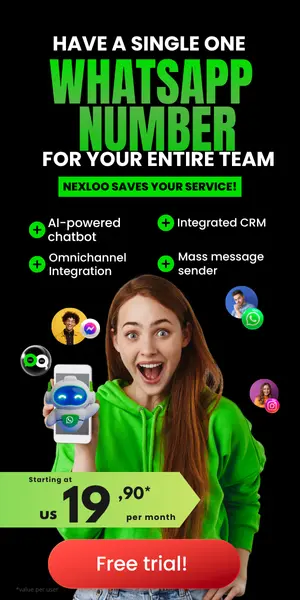In recent years, the landscape of customer engagement and sales processes has dramatically evolved, primarily due to the rise of automated technologies such as sales bots. These programmed systems, especially when integrated into popular messaging applications like WhatsApp, offer a game-changing approach to how businesses interact with their customers. This article delves into the intricacies of developing a sales bot that not only streamlines operations but also enhances customer experience, paving the way for better engagement and increased sales conversions.
Sales bots are designed to automate customer interactions, allowing businesses to manage inquiries efficiently and respond to customer needs around the clock. Imagine a virtual assistant that never sleeps — ready to provide information on products, assist with inquiries, or guide potential buyers through their journey, all without the limitations of human availability. With an appropriately designed sales bot, businesses can create a seamless communication channel that caters to their customers’ needs, boosting satisfaction and ultimately driving sales.
However, creating an effective sales bot involves careful planning and execution. Understanding the underlying technology, the specific functionalities required, and how to optimize the bot for continuous improvement are crucial steps that can be the difference between a successful implementation and a frustrating experience. So, let us explore the fundamental aspects of designing a sales bot on WhatsApp, its benefits, and vital tips for overcoming challenges along the way.
Understanding the Basics of a Sales Bot
A sales bot is a programmed system integrated into messaging applications like WhatsApp, designed to automate customer interactions and streamline various sales processes. By leveraging a bot, businesses can manage inquiries efficiently, answer frequently asked questions, and assist customers in their buying journey without the need for constant human supervision. This not only enhances customer experience by providing instantaneous responses but also empowers businesses to optimize their sales operations.
When creating a sales bot, it’s essential to understand how it functions. At its core, a sales bot uses artificial intelligence to interpret user messages and respond appropriately based on pre-defined scripts or learned interactions. It is capable of engaging users through a variety of queries, such as product details, pricing, order tracking, and even recommendations, thereby imitating a human-like interaction. The effectiveness of a sales bot relies significantly on the quality of its programming and the natural language processing capabilities, ensuring that it can handle diverse customer inquiries accurately.
To establish a sales bot, you generally begin by selecting a bot-building platform, many of which offer user-friendly interfaces suitable for business owners with minimal technical expertise. After defining your bot’s purpose, you craft conversational flows that guide customer interactions. Incorporating contextual elements into the chatbot’s responses can create a more personalized experience for users. Moreover, integrating the sales bot with existing CRM systems and databases can provide real-time updates and insights into customer data, enhancing the bot’s ability to deliver relevant information promptly.
Finally, ongoing management and optimization of the sales bot are crucial for maximizing its effectiveness. This involves regularly reviewing interactions to identify common queries and areas for improvement, updating scripts to adapt to changes in business offerings or customer preferences, and leveraging analytics to track performance and make data-driven adjustments. Employing a well-structured approach to creating and managing a sales bot on WhatsApp can lead to substantial advantages, including reduced operational costs, improved customer satisfaction, and ultimately, increased sales conversion rates.
Enhancing Sales Optimization Strategies with a Sales Bot
The implementation of a sales bot on WhatsApp can significantly enhance sales optimization strategies, providing businesses with a streamlined way to engage customers and drive conversions. One of the primary benefits of using a sales bot is its ability to operate 24/7, ensuring that customers can interact with your business anytime, anywhere. This constant availability not only improves customer satisfaction but also increases the likelihood of capturing leads outside traditional business hours.
By addressing inquiries and guiding prospects through the sales funnel around the clock, the bot plays a critical role in maximizing sales opportunities. Furthermore, a sales bot can handle a multitude of interactions simultaneously, eliminating the bottleneck often experienced with human agents. This capability is particularly advantageous during peak hours or promotional events when customer inquiries surge. By deploying a sales bot, businesses can ensure that every customer interaction is acknowledged and responded to, reducing potential lost sales due to slow response times.
Moreover, the bot can provide consistent responses, adhering to the company’s messaging and tone, which builds trust and credibility with clients. The automation aspect of a sales bot also extends to lead qualification and nurturing. By using predefined criteria, the bot can identify high-potential prospects and segment them accordingly, allowing sales teams to focus their efforts where they matter most. For instance, the bot can ask questions designed to gauge interest and qualify leads based on their responses.
This efficient lead management ensures that sales professionals engage with well-informed prospects, enhancing their chances of closing deals. Lastly, integrating a sales bot with analytics tools allows businesses to gather valuable insights into customer interactions and preferences. Tracking metrics such as common queries, conversion rates, and user engagement patterns enables continual refinement of sales strategies. Therefore, embracing a sales bot on WhatsApp not only boosts efficiency but also enhances the overall effectiveness of sales optimization efforts.
Steps for Creating Your Sales Bot
Creating an automated sales bot on WhatsApp can significantly enhance your sales process, leading to improved customer interactions and sales optimization. This step-by-step guide will walk you through the essentials of developing a sales bot tailored for your business’s needs. First, you need to identify the key functionalities your sales bot should have. Consider common inquiries from customers, product details, pricing information, and order status updates. Knowing these requirements will help you design a bot that meets customer expectations.
Once you have a clear vision, you’ll need to select a platform that supports WhatsApp bots, such as Twilio, Dialogflow, or Chatfuel. These platforms integrate well with messaging apps and provide the necessary tools for creating automated interactions. After selecting a platform, the next step is to set up a WhatsApp Business Account. This is crucial because the automated bot will operate under this account. Follow the platform’s guidelines to authenticate your WhatsApp Business Account and connect it with the chosen bot-building platform.
This process typically involves verifying your phone number and setting up your business profile. Make sure your profile is complete with your business name, description, and contact details to enhance credibility and trust with customers. Once connected, you can begin creating the chatbot’s script. Start by mapping out potential conversation flows. Make use of tools like decision trees to visualize how different customer inputs lead to specific responses.
It’s essential to incorporate both automated responses for frequently asked questions and options for customers to connect with a human representative if necessary. This hybrid approach ensures that while the bot can handle basic inquiries, customers still receive personal attention when needed. After the script is established, test your bot rigorously. Use various scenarios to see how well it handles different customer queries and make necessary adjustments based on the feedback. Once iterations are completed, launch your sales bot and promote it through your marketing channels.
Essential Features for an Effective Sales Bot
A criação de um Sales Bot eficaz no WhatsApp requer a implementação de características essenciais que não apenas melhorem a interação com os clientes, mas também otimizem o processo de vendas. Primeiramente, é fundamental incluir um sistema de respostas automáticas. Essa funcionalidade permite que os usuários sejam atendidos imediatamente, respondendo a consultas comuns sobre produtos, serviços e políticas, reduzindo a carga de atendimento manual. A capacidade de fornecer respostas rápidas e precisas gera uma experiência do cliente mais fluida e eficiente.
Em segundo lugar, a personalização é uma característica indispensável. É importante que o Sales Bot possa coletar e analisar dados dos usuários para personalizar as interações. Esse recurso ajuda a oferecer recomendações de produtos adaptadas aos interesses do cliente, além de enviar mensagens personalizadas em momentos estratégicos, como aniversários ou promoções. Essa abordagem não só aumenta as chances de conversão, mas também fortalece o relacionamento com o cliente.
Outro elemento essencial é a integração com ferramentas de CRM (Customer Relationship Management). Por meio dessa integração, o Sales Bot pode acessar informações previamente coletadas sobre os clientes, permitindo um atendimento mais diodo e contextualizado. Além disso, essa conexão ajuda a equipe de vendas a monitorar o progresso do funil de vendas e a acompanhar as interações realizadas, permitindo ajustes na estratégia conforme necessário.
Por fim, incluir a funcionalidade de rastreamento de pedidos e feedback pode ser um diferencial significativo. Os clientes apreciam a transparência e a capacidade de acompanhar seus pedidos em tempo real. Além disso, o Sales Bot deve ser capaz de solicitar avaliações e feedbacks, proporcionando à empresa insights valiosos sobre o desempenho dos produtos e serviços. Esses recursos não apenas aumentam a satisfação do cliente, mas também fornecem dados importantes para ajustes estratégicos que podem direcionar a otimização das vendas. Em resumo, a implementação dessas características garante que seu Sales Bot no WhatsApp seja uma ferramenta poderosa para impulsionar as vendas e melhorar a experiência do cliente.
Challenges and Solutions in Implementing a Sales Bot
Implementing a sales bot on WhatsApp can significantly enhance sales optimization and streamline customer interactions, but it’s not without its challenges. One common hurdle is the integration of the bot with existing CRM systems. Many businesses find that their current platforms may not support smooth communication with the WhatsApp API, leading to disjointed processes. To overcome this, it is crucial to choose a sales bot solution that offers seamless integration capabilities with popular CRM systems.
Conducting thorough research and perhaps opting for a customizable bot solution can also provide the flexibility needed for better alignment with your current systems. Another challenge lies in the crafting of the bot’s conversational flows. Many entrepreneurs underestimate the importance of designing intuitive and effective message paths that can cater to diverse customer needs. Poorly designed interactions can lead to customer frustration and abandonment.
To tackle this, businesses should engage in comprehensive planning and testing of the conversation scenarios. Analyzing customer inquiries and anticipated responses will help in creating a more user-friendly experience. Additionally, seeking feedback from actual users during pilot testing can provide valuable insights for improvement. Data privacy and customer trust constitute another layer of challenge when deploying a sales bot on messaging apps like WhatsApp.
As data protection regulations become stricter, businesses must ensure that customer data is handled ethically and in compliance with legal standards. This involves implementing robust security measures and being transparent about data usage. To avoid potential pitfalls, it’s advisable to include clear data protection policies within the bot’s conversations, allowing customers to understand how their information will be utilized.
Success Stories of Sales Bots in Action
Successful businesses have embraced sales bots on WhatsApp as a powerful tool for optimizing their sales processes and enhancing customer engagement. A prime example is a leading e-commerce retailer that implemented a sales bot to assist customers in locating products and answering frequently asked questions. By offering personalized recommendations and instant responses, they not only reduced the workload on their customer service team but also increased their conversion rates significantly.
Customers appreciate the seamless experience and are more likely to complete their purchases when they receive immediate assistance through the messaging app. Another notable success story comes from a travel agency that deployed a sales bot to streamline inquiries and bookings. The bot assists potential travelers in selecting holiday packages, answering questions about destinations, and providing real-time availability. This not only simplified the booking process but also led to a marked improvement in customer satisfaction.
Clients enjoy the convenience of receiving travel information and booking options directly on WhatsApp, reflecting a growing trend where customers prefer immediate access to services through familiar platforms. A local restaurant used a WhatsApp sales bot to manage online reservations and menu inquiries effectively. By integrating the bot into their operational workflow, they allowed diners to check table availability and view daily specials instantly.
This innovation significantly reduced wait times for customers and optimized the restaurant’s scheduling efficiency. The outcome was a streamlined reservation process that contributed to a noticeable rise in patron visits and positive reviews on social media. Finally, a niche online fitness brand leveraged a sales bot to guide customers through their purchase journey, offering tailored workout plans and product suggestions.
Future Trends and Innovations in Sales Automation
Future trends in sales automation and messaging apps are reshaping how businesses engage with customers and streamline their operations. The emergence of advanced AI-driven sales bots, particularly on platforms like WhatsApp, signifies a shift towards more personalized, efficient customer interactions. These sales bots are not just tools for response management; they are becoming essential components of sales strategies, providing a seamless experience for both businesses and customers.
As businesses increasingly adopt messaging apps for customer engagement, the optimization of sales processes through automation becomes paramount. Sales bots enable quick and consistent responses to customer inquiries, reducing wait times and improving user satisfaction. Moreover, they can manage multiple conversations simultaneously, allowing sales teams to focus on high-priority leads or complex issues that require human intervention.
Another significant trend is the adaptation of sales bots to analyze customer data and behavior patterns. By employing machine learning algorithms, sales bots can offer personalized product recommendations based on previous interactions, enhancing the chances of conversion. This data-driven approach ensures that the messaging remains relevant and effective, making each interaction feel tailored to individual customer needs.
Furthermore, the use of chat history allows for a continuous dialogue that fosters customer loyalty and repeat business. In addition, future innovations in messaging apps are likely to support sales bots with enriched functionalities, such as voice recognition and natural language processing. These advancements will allow for more natural conversations and enable users to interact in a more intuitive manner.
As businesses and consumers become more comfortable with automated interfaces, the reliance on sales bots is expected to rise, marking a transformative phase in how sales are conducted. Blending human touch with automated processes will not only optimize sales efforts but also redefine the overall customer experience in the digital marketplace.
The future of sales is undeniably intertwined with the advancement of automated bots, specifically in messaging apps like WhatsApp. As businesses continue to strive for greater efficiency and optimization, sales bots emerge as powerful tools that not only streamline communication but also enhance customer engagement. By automating routine tasks, sales teams can focus on strategic activities that drive growth, ultimately leading to improved sales performance.
An automated sales bot on WhatsApp can transform the customer experience by providing instant responses, personalized interactions, and 24/7 support. This convenience is increasingly important in today’s fast-paced market, where customers expect quick and effective communication. Moreover, with the ability to handle numerous inquiries simultaneously, sales bots reduce the workload on human agents, allowing them to dedicate more time to complex customer needs and high-value sales opportunities.
The integration of AI and machine learning into sales bots further propels their effectiveness. By analyzing customer behavior and preferences, these bots can offer tailored product recommendations, increasing upsell and cross-sell opportunities. This data-driven approach not only maximizes sales potential but also fosters a more personal relationship between brands and their customers, contributing to long-term loyalty.
In conclusion, adopting automated sales bots within platforms like WhatsApp is not merely a trend but a necessary evolution in the sales landscape. As business owners, sales managers, and customer service professionals adapt to these innovations, they will find that leveraging sales bots can lead to significant improvements in efficiency, customer satisfaction, and ultimately, revenue. Preparing for this shift will ensure that businesses remain competitive and responsive to emerging demands and technologies in the years to come.









